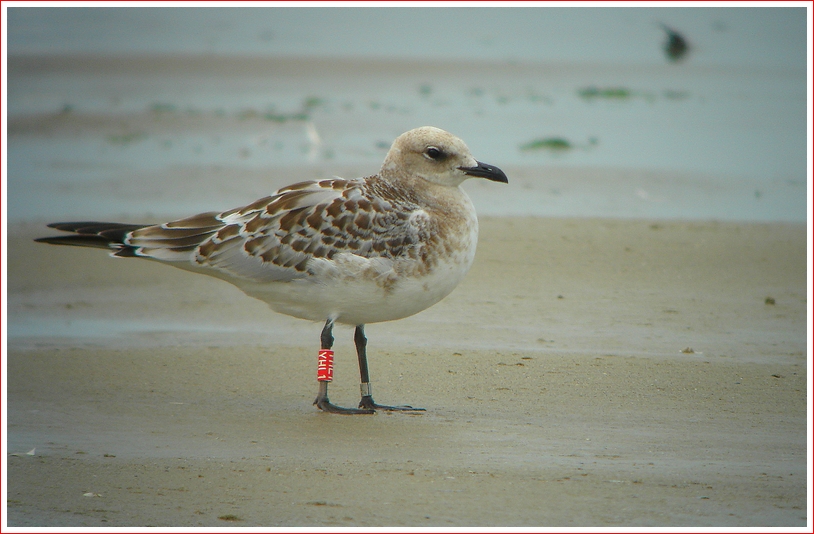 Mediterranean Gull (L. melanocephalus)
Mediterranean Gull (L. melanocephalus)
(last update:
Mediterranean Gull 1cy YHL1 August 07 2009, Le Portel / Boulogne-sur-Mer, NW France. Picture: Jean-Michel Sauvage.
Ringing data: ringed as pullus on 24 May 2009 at Palic Lake, Subotica, Monténégro - Servia (46.04N 19.44E). Distance to Le Portel: 1432 Km.
In juvenile plumage, the head is uniform pale buffish-brown with slightly darker ear-coverts and a pale throat. Juvenile birds have a blackish smudge in front of the eye and white crescents above and below the eye. The brown colour of the head extends onto the neck, forming a barred collar running down along the sides of the breast to the flanks. The under-parts and rump are white. The scapulars and mantle feathers are deep brown with an inconspicuous dark sub-terminal band and a silvery-white fringe, creating a scaly pattern.
The pattern of the scapulars is repeated on the lesser coverts, lower lesser coverts, median coverts, inner three to four greater coverts and upper tertials which also show brown centres and neat silvery-white fringes. They contrast strongly with the central and outer greater coverts, which are predominantly grey, forming a pale bar in the dark inner-wing in flight, as the secondaries are dark blackish-centred as well (but with broad white tips). The inner primaries are largely white-grey, the grey slightly decreasing in the primaries outwards, reduced to parts of the inner-webs in the outer primaries P9 and P10. The under-wing coverts are all-white, but there are neat black tips on the under-wing greater primary coverts. The white tail has a clear-cut black sub-terminal band, widest on t1-2, very thin on the outer rectrices (t6 can be completely white). The iris is dark brown, the legs are usually very dark horn, the bill is blackish.
The complete juvenile plumage lasts for only a short period in Mediterranean Gulls as they start to moult soon after fledging. This post-juvenile moult is a partial moult into so-called "first winter" plumage that starts from the moment the birds leave their colonies in July and will be finished by late September. This moult includes most of the head and body feathers. The head and under-parts become almost completely white, with a dark mask of variable size and intensity behind the eye extending as very narrow streaks over the nape. The eye-crescents are white and the dark smudge in front of the eye contrasts more than in full juvenile plumage. The second generation wing-coverts, mantle and scapular feathers are plain pale grey. The rich brown centres of the juvenile wing-covert centres bleach to a foxy brown and the white fringes quickly wear away. In most birds at least some wing-coverts are included in the post-juvenile moult. The extent of this covert moult is variable, in a few birds nearly all are moulted, in others all juvenile coverts are retained until the next complete moult that starts in May of the next year. All juvenile feathers show wear by September, contrasting with the recently moulted second generation feathers. The base of the bill starts to turn paler and the legs turn slightly paler as well.
Note that the comments on moult are based on observations of juveniles from and in Western Europe. More easterly fledged Mediterranean Gulls may postpone their moult to first winter until later in the autumn and very fresh looking juveniles may be encountered well into October.
